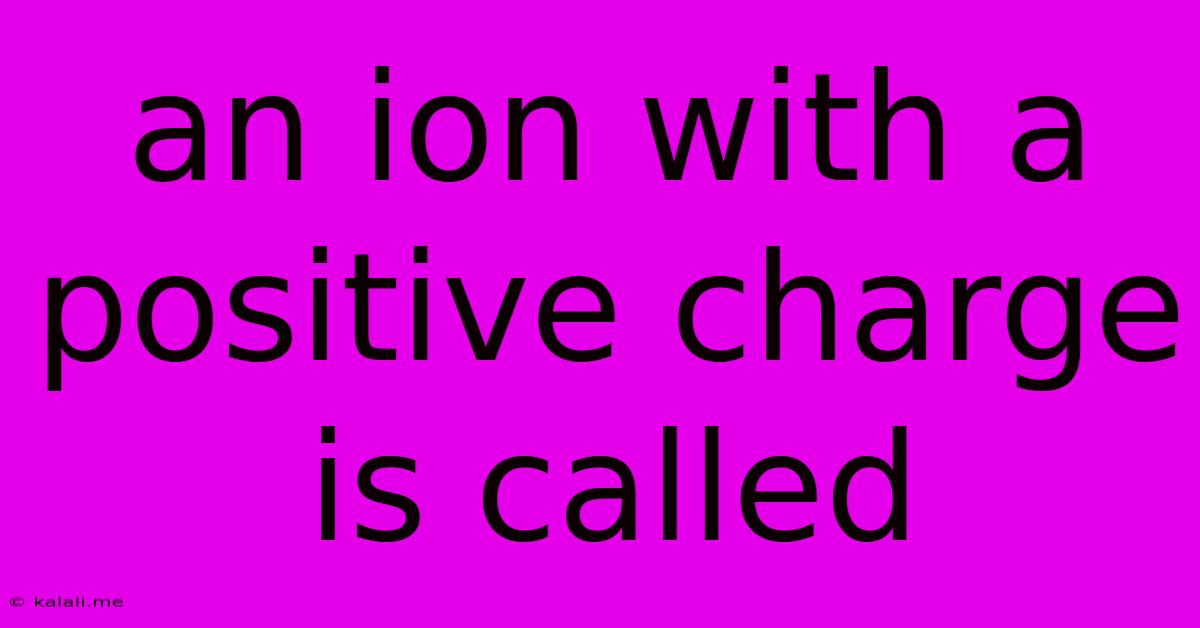An Ion With A Positive Charge Is Called
Kalali
Jun 14, 2025 · 3 min read

Table of Contents
An Ion with a Positive Charge is Called a Cation: A Deep Dive into Ionic Charges
A positively charged ion is called a cation. This seemingly simple definition opens the door to a fascinating world of chemistry, encompassing fundamental concepts like atomic structure, chemical bonding, and the behavior of matter. This article will explore the nature of cations, their formation, properties, and their importance in various fields. Understanding cations is crucial for comprehending a wide range of chemical processes and phenomena.
What is an Ion?
Before delving into cations specifically, let's establish a clear understanding of ions in general. An ion is an atom or molecule that carries an electric charge. This charge arises from an imbalance between the number of protons (positively charged particles) and electrons (negatively charged particles) within the atom or molecule. When an atom loses one or more electrons, it acquires a net positive charge, becoming a cation. Conversely, when an atom gains one or more electrons, it acquires a net negative charge, becoming an anion.
Cation Formation: The Loss of Electrons
Cations are formed through the process of ionization, where an atom loses one or more of its valence electrons. Valence electrons are the electrons located in the outermost shell of an atom; these electrons are loosely bound and are most likely to be involved in chemical bonding. The loss of these electrons results in a positively charged ion because the number of protons now exceeds the number of electrons.
The tendency of an atom to lose electrons and form cations is influenced by several factors, including its electronegativity and its position in the periodic table. Atoms with low electronegativity – those that do not strongly attract electrons – are more likely to lose electrons and form cations. Elements in groups 1 (alkali metals) and 2 (alkaline earth metals) are particularly prone to forming cations, readily losing one and two electrons respectively to achieve a stable electron configuration.
Examples of Common Cations
Many common elements form cations. Some prominent examples include:
- Sodium cation (Na+): Sodium readily loses one electron to become a sodium cation.
- Calcium cation (Ca2+): Calcium loses two electrons to form a calcium cation.
- Potassium cation (K+): Potassium loses one electron to form a potassium cation.
- Iron(II) cation (Fe2+) and Iron(III) cation (Fe3+): Iron can lose two or three electrons, forming different cations with different charges. This demonstrates the ability of some elements to form multiple cations.
- Aluminum cation (Al3+): Aluminum loses three electrons to form an aluminum cation.
Properties and Significance of Cations
Cations play crucial roles in various natural and industrial processes. Their properties are significantly different from their neutral atom counterparts. For instance, cations often exhibit different chemical reactivity, different ionic radii, and different physical properties.
- Chemical Reactivity: The positive charge of cations makes them highly reactive, often participating in ionic bonding with anions to form stable ionic compounds.
- Biological Importance: Many cations are essential for biological functions. For example, sodium, potassium, calcium, and magnesium cations play vital roles in nerve impulse transmission, muscle contraction, and enzyme activity.
- Industrial Applications: Cations are involved in numerous industrial applications, including metallurgy, electroplating, and the production of various chemicals and materials.
In Conclusion
Understanding the concept of a cation – a positively charged ion formed by the loss of electrons – is fundamental to grasping many chemical principles and applications. Its formation, properties, and importance across diverse fields highlight its significance in both the natural world and human endeavors. From the biological processes within our bodies to industrial applications shaping our modern world, cations play an indispensable role.
Latest Posts
Latest Posts
-
Lcm Of 4 6 And 9
Jun 15, 2025
-
Least Common Multiple Of 30 And 45
Jun 15, 2025
-
Which Of The Following Is Not A Component Of Fitness
Jun 15, 2025
-
Which Of The Following Destroys All Microbial Life
Jun 15, 2025
-
Example Of Motivation Letter For Job Application Pdf
Jun 15, 2025
Related Post
Thank you for visiting our website which covers about An Ion With A Positive Charge Is Called . We hope the information provided has been useful to you. Feel free to contact us if you have any questions or need further assistance. See you next time and don't miss to bookmark.